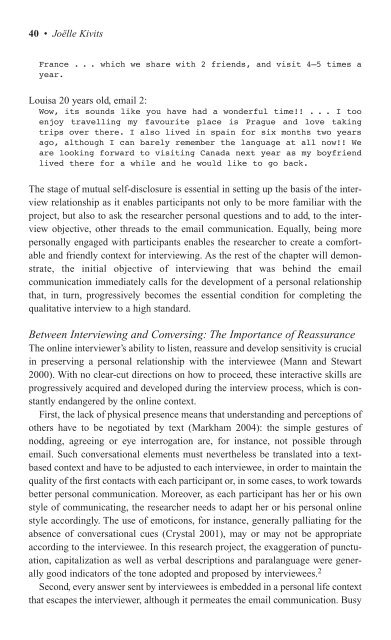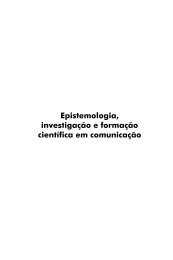Virtual Methods
Virtual Methods
Virtual Methods
Create successful ePaper yourself
Turn your PDF publications into a flip-book with our unique Google optimized e-Paper software.
40 • Joëlle Kivits<br />
France . . . which we share with 2 friends, and visit 4–5 times a<br />
year.<br />
Louisa 20 years old, email 2:<br />
Wow, its sounds like you have had a wonderful time!! . . . I too<br />
enjoy travelling my favourite place is Prague and love taking<br />
trips over there. I also lived in spain for six months two years<br />
ago, although I can barely remember the language at all now!! We<br />
are looking forward to visiting Canada next year as my boyfriend<br />
lived there for a while and he would like to go back.<br />
The stage of mutual self-disclosure is essential in setting up the basis of the interview<br />
relationship as it enables participants not only to be more familiar with the<br />
project, but also to ask the researcher personal questions and to add, to the interview<br />
objective, other threads to the email communication. Equally, being more<br />
personally engaged with participants enables the researcher to create a comfortable<br />
and friendly context for interviewing. As the rest of the chapter will demonstrate,<br />
the initial objective of interviewing that was behind the email<br />
communication immediately calls for the development of a personal relationship<br />
that, in turn, progressively becomes the essential condition for completing the<br />
qualitative interview to a high standard.<br />
Between Interviewing and Conversing: The Importance of Reassurance<br />
The online interviewer’s ability to listen, reassure and develop sensitivity is crucial<br />
in preserving a personal relationship with the interviewee (Mann and Stewart<br />
2000). With no clear-cut directions on how to proceed, these interactive skills are<br />
progressively acquired and developed during the interview process, which is constantly<br />
endangered by the online context.<br />
First, the lack of physical presence means that understanding and perceptions of<br />
others have to be negotiated by text (Markham 2004): the simple gestures of<br />
nodding, agreeing or eye interrogation are, for instance, not possible through<br />
email. Such conversational elements must nevertheless be translated into a textbased<br />
context and have to be adjusted to each interviewee, in order to maintain the<br />
quality of the first contacts with each participant or, in some cases, to work towards<br />
better personal communication. Moreover, as each participant has her or his own<br />
style of communicating, the researcher needs to adapt her or his personal online<br />
style accordingly. The use of emoticons, for instance, generally palliating for the<br />
absence of conversational cues (Crystal 2001), may or may not be appropriate<br />
according to the interviewee. In this research project, the exaggeration of punctuation,<br />
capitalization as well as verbal descriptions and paralanguage were generally<br />
good indicators of the tone adopted and proposed by interviewees. 2<br />
Second, every answer sent by interviewees is embedded in a personal life context<br />
that escapes the interviewer, although it permeates the email communication. Busy



